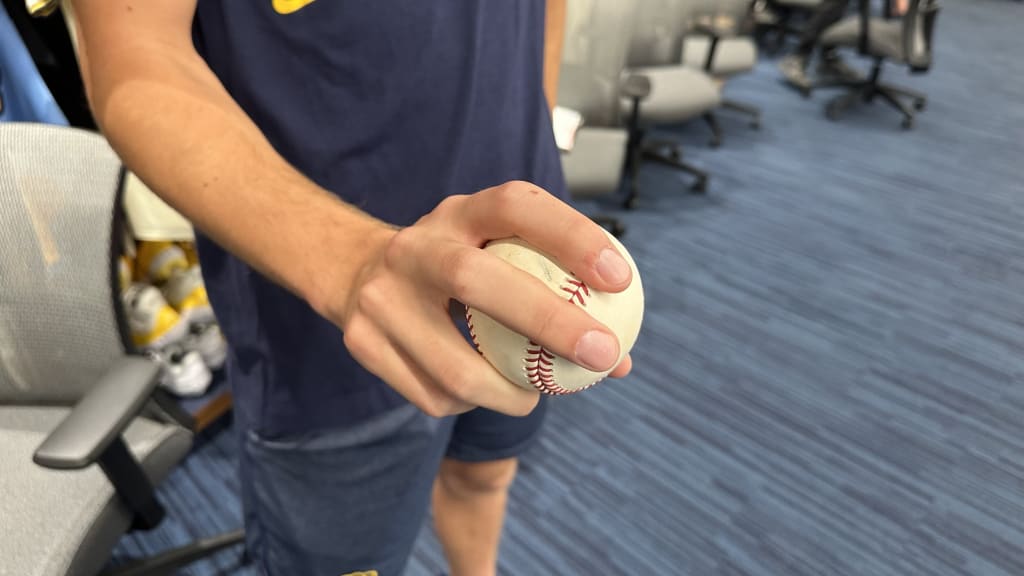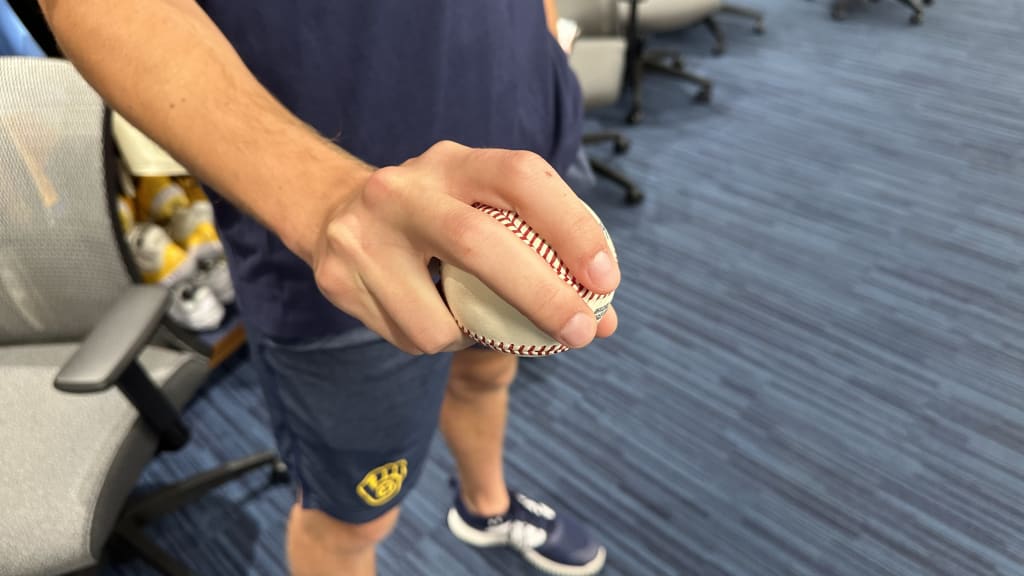This story was excerpted from Adam McCalvy’s Brewers Beat newsletter. To read the full newsletter, click here. And subscribe to get it regularly in your inbox.
The Brewers' Top 30 prospects list for 2024 was just unveiled by MLB Pipeline. Let's take a look at the team's top two pitching prospects, who've both showcased their nasty stuff at Spring Training.
Milwaukee's top right-handed pitching prospect is 21-year-old Jacob Misiorowski, who comes in at No. 2 in the club's top 30 and No. 33 in MLB. The Brewers' top lefty is 24-year-old Robert Gasser, who's ranked the organization’s No. 6 prospect and MLB's No. 9 left-handed pitching prospect.
MLB.com sat down with Misiorowski and Gasser -- who we might see in the upcoming Spring Breakout (rosters will be announced this Thursday) -- to discuss their pitch arsenals.
JACOB MISIOROWSKI
4-seam fastball

The 6-foot-7 right-hander has an explosive fastball that sits in the upper 90s and frequently reaches triple digits. Misiorowski's goal is to drive down the mound and make it seem even faster.
"It's about getting extension, reaching out and really finishing through it," Misiorowski said. "I'm basically trying to drop it in the catcher's mitt."
Slider

Misiorowski's mid-80s slider is a wipeout pitch. You might notice that he throws it with his fingers around the seam of the baseball, a grip he developed at Crowder College in Neosho, Mo.
"On the slider, I'm thinking ‘fastball’ when I throw it," Misiorowski said. "I just got more comfortable with the seam being split between my index and middle finger. I probably started that my freshman year of college, so I've been throwing it that way two or three years."
Curveball
Misiorowski's curveball is his secondary breaking pitch. In his mind, the key to his curve is his thumb placement on the ball.
"There's a reason I have my thumb so far up: I'm actually thinking, 'Flip the thumb over' and really point the thumb at the hitter," Misiorowski said. "That's always been the cue, ever since I started throwing it. That's just the way I was taught.
"I was taught with a spike-curve, and all of a sudden it transformed into what it is now. It felt weird in the glove, so I changed it a little bit, it felt good and we went with it."
Changeup
The changeup, a normal circle-change, is Misiorowski's fourth pitch and still developing. But he's made big progress since joining the Brewers.
"I've gotten a lot of help from the guys here," Misiorowski said. "It's come a long way. There was no changeup in college. And now I have one. It's a real weapon now. At first, I wasn't [turning] over it, and I didn't understand it. Then I got here, and they started showing me data, and it started coming around."
ROBERT GASSER
4-seam fastball
Where Misiorowski is all power stuff, Gasser is finesse. The 6-foot southpaw sits 91-94 mph with his fastball, but his low release point makes it play up like a higher-velocity four-seamer, and mixing it evenly with cutters and sweeping sliders stops hitters from keying on it.
"The key is the [vertical approach angle]," Gasser said. "I've got a really low release, and when I throw it up in the zone, it's got some pretty elite metrics. Since my release height's nearly a foot below the average release, it has that appeal [of a rising fastball]. It has those effects visually. And the pitch usage keeps it more effective than if I was to live off of it."
Sinker
Gasser uses his sinker to attack left-handed hitters, since the pitch pounds in on them instead of running with their barrel. His fingers are placed inside the seam of the baseball.
"Honestly, it's a feel thing," Gasser said. "I've had so many different grips with it. Initially, in high school, I started straight up on the two seams. Then I went to the inside. Then I started graduating towards here. Now I just play with the thumb position. I know if I go up more, it's going to have a little more sink. If I go more underneath, it's going to run more."
Sweeper
Gasser throws the "sweeper" style of slider with big horizontal movement. His sweeper was breaking upwards of 20 inches in his Spring Training debut. He throws it in the low 80s, an important velocity difference from the rest of his arsenal. It's his best pitch.
"I want to make sure it's getting good velo separation," Gasser said. "All my other pitches are in a similar category for speed. I want to make sure that I'm not losing movement for added velocity, because it's a pitch that helps me change speeds with hitters."
Cutter
Gasser throws an upper-80s cutter that helps him command the zone and works in tandem with his sweeper.
"I added the cutter right when I got to professional baseball," Gasser said. "I wanted to throw a harder slider, and initially that's what it was.
"It works, just because of how much separation my sweeper has from my fastball. Anything in between that range, splitting the two, puts me in a good spot. … I've gotten good feedback from hitters on my team, as well as other teams, that the tunneling of the cutter and the sweeper are really good, and it's hard to pick up."
Changeup
Gasser rarely threw his upper-80s changeup last year, his first full season in the Brewers organization after coming over in the Josh Hader trade. But the pitch is improving.
"Early this spring, I've been very proactive in just throwing it in catch play," Gasser said. "My throwing partner, [Brewers left-hander] Evan McKendry, has a really good changeup. So I like to throw with him and just see him throw it. He throws it, and I'm like, 'I'm going to throw it right back at him.' Try to replicate it.
"The metrics are always really good on it -- I really love the metrics. It's more just the location. I'm not necessarily trying to replicate [McKendry's] grip or the spin. It's just seeing how he throws it and sells it with his arm and trying to do that myself."
David Adler is a reporter for MLB.com based in New York.
